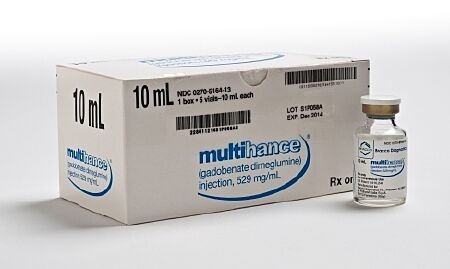

MULTIHANCE 529 mg/ml INJECTABLE SOLUTION

Ask a doctor about a prescription for MULTIHANCE 529 mg/ml INJECTABLE SOLUTION

How to use MULTIHANCE 529 mg/ml INJECTABLE SOLUTION
Introduction
Package Leaflet: Information for the User
MultiHance 529 mg/ml Solution for Injection
Gadobenate dimeglumine
Read all of this leaflet carefully before you start using this medicine because it contains important information for you.
|
Contents of the package leaflet:
- What is MultiHance and what is it used for
- What you need to know before you use MultiHance
- How to use MultiHance
- Possible side effects
- Storage of MultiHance
- Contents of the pack and other information
1. What is MultiHance and what is it used for
MultiHance is a special dye (or contrast medium) that contains the metal gadolinium and improves liver images in Magnetic Resonance Imaging (MRI) scans. This helps your doctor identify abnormalities in your liver.
This medicine is for diagnostic use only.
MultiHance is approved for use in children over 2 years of age.
2. What you need to know before you use MultiHance
MultiHance should only be administered in hospitals or clinics where there are facilities and medical personnel trained to treat allergic reactions.
Accumulation in the body
MultiHance works because it contains a metal called gadolinium. Studies have shown that small amounts of gadolinium can accumulate in the body, including the brain. No adverse effects due to gadolinium accumulation in the brain have been observed.
Do not use MultiHance
- if you are allergic to gadobenate dimeglumine or any of the other ingredients of this medicine (listed in section 6).
- if you have previously had any allergic reaction (hypersensitivity reaction), such as rash, itching, hives, or difficulty breathing after injection of any contrast medium for MRI.
Consult your doctor if you think you may be in one of these situations.
Children
MultiHance should not be administered to children under 2 years of age.
Warnings and precautions
Consult your doctor before starting to use MultiHance if:
- you have a heart problemor high blood pressure
- you have a history of epilepsy or brain injuries
- you have a pacemakeror any other metal object such as clips, screws, or plates in your body, as they may interfere with the MRI scanner's magnet
- your kidneys do not work properly
- if you have recently undergone, or are about to undergo, a liver transplant.
Your doctor may decide to perform a blood test to check your kidneys are working properly before deciding to use MultiHance, especially if you are 65 years old or older.
Using MultiHance with other medicines
There are no data on interactions between MultiHance and other medicines.
Tell your doctor if you are using, have recently used, or might use any other medicines.
Pregnancy and breastfeeding
Consult your doctor before taking any medicine.
Pregnancy:
Gadobenate crosses the placenta. It is not known if it affects the fetus. You should inform your doctor if you are pregnant or think you might be pregnant or plan to become pregnant, as MultiHance should not be used during pregnancy unless it is strictly necessary.
Breastfeeding:
Tell your doctor if you are breastfeeding or about to start. Your doctor will assess whether you should continue breastfeeding or interrupt it 24 hours after administration of MultiHance.
Driving and using machines
No effects of MultiHance on driving or using tools or machines have been observed. Ask your doctor if you can drive and if it is safe to use any tools or machines.
Important information about some of the ingredients of MultiHance
During storage, the MultiHance solution may release small amounts of benzyl alcohol (an alcohol derivative).
Please inform your doctor if you are allergic to benzyl alcohol.
3. How to use MultiHance
MultiHance is injected into a vein, usually in the arm, before the MRI scan. The amount in milliliters to be injected depends on your body weight.
The recommended dose is:
Liver MRI:0.1 ml per kilogram of body weight
The medical staff responsible for the scan will administer the MultiHance injection. They should ensure the needle is correctly placed: inform them if you feel pain or a burning sensation at the injection site during administration.
You should stay in the hospital for the hour following the injection.
Dosage in special populations
Renal insufficiency
The use of MultiHance is not recommended in patients with severe kidney problems or in patients who have recently undergone, or are about to undergo, a liver transplant. However, if use is required, during a scan, only one dose of MultiHance should be administered and a second injection should not be given until at least 7 days have passed.
Elderly patients
If you are 65 years old or older, it is not necessary to adjust the dose, but a blood test may be performed to check your kidneys are working properly.
If you use more MultiHance than you should
In case of overdose, you will be closely monitored and treated symptomatically.
In case of overdose, consult your doctor immediately or call the Toxicology Information Service, phone: 91 562 04 20, indicating the medicine and the amount administered.
If you have any further questions on the use of this medicine, ask your doctor.
4. Possible side effects
Like all medicines, MultiHance can cause side effects, although not everybody gets them. Most side effects reported with MultiHance have been mild, not prolonged, and resolved spontaneously without residual effects. However, serious and potentially life-threatening reactions have been reported, which in some cases have led to death.
Possible side effects | |
Common: (More than 1 in 100 people and less than 1 in 10 people) |
|
Uncommon: (More than 1 in 1,000 people and less than 1 in 100 people) |
|
Rare: (More than 1 in 10,000 people and less than 1 in 1,000 people) |
|
Frequency not known (Cannot be estimated from the available data) |
|
There have been reports of nephrogenic systemic fibrosis (which causes skin hardening and may also affect soft tissues and internal organs) in patients who were given MultiHance together with other gadolinium-based contrast agents.
If you think you feel any side effect after the injection of MultiHance, inform the medical staff responsible for your scan immediately.
If after reading this leaflet you have any further questions, please ask the medical staff responsible for your scan.
Reporting of side effects
If you experience any side effects, talk to your doctor, even if it is possible side effects not listed in this leaflet. You can also report side effects directly through the Spanish Medicines Information System for Human Use: www.notificaRAM.es. By reporting side effects, you can help provide more information on the safety of this medicine.
5. Storage of MultiHance
- Keep this medicine out of the sight and reach of children.
- Do not use this medicine after the expiry date which is stated on the carton after EXP. The expiry date refers to the last day of the month shown.
- Do not freeze.
- MultiHance should be administered immediately after loading into the syringe.
- Do not use MultiHance if you notice that the packaging and closure have been damaged, the solution has discolored, or there is any other problem.
- Medicines should not be disposed of via wastewater or household waste. The hospital pharmacy will dispose of unused product or waste material. This helps to protect the environment.
6. Contents of the pack and other information
Composition of MultiHance
- The active substance is gadobenic acid in the form of gadobenate dimeglumine
- 1 ml of the solution for injection contains: 334 mg of gadobenic acid (0.5 mmol) as gadobenate dimeglumine (529 mg).
- The other ingredient (excipient) is water for injections.
Appearance and packaging of the product
MultiHance is a sterile aqueous solution (particle-free, clear or slightly yellowish) for intravenous injection.
MultiHance is supplied to hospitals in single-dose glass vials containing 5 ml, 10 ml, 15 ml, or 20 ml of solution.
MultiHance is also supplied in kits with administration devices: vials of 15 and 20 ml, syringe for automatic MRI injector (65 ml syringe (polyethylene terephthalate/polycarbonate), 115 ml syringe (polyethylene terephthalate/polycarbonate), connector (PVC/polycarbonate/polypropylene/silicone), 2 tips (ABS)), safety catheter 20 G.
Not all pack sizes may be marketed.
Marketing authorisation holder and manufacturer
Marketing authorisation holder:
Bracco Imaging s.p.a.
Via Egidio Folli, 50
20134 Milan (Italy)
Manufacturer:
Patheon Italia s.p.a.
2nd Trav. SX Via Morolense, 5
03013 Ferentino (Italy)
BIPSO GmbH
Robert-Gerwig-Strasse 4
78224 Singen (Germany)
Bracco Imaging S.p.A.
Bioindustry Park - Via Ribes, 5
10010 Colleretto Giacosa (TO) (Italy)
You can request more information about this medicine from the local representative of the marketing authorisation holder:
Laboratorios Farmacéuticos ROVI, S.A.
Julián Camarillo, 35
28037 Madrid
Tel: 913756230
Date of last revision of this leaflet: May 2024
Detailed and up-to-date information on this medicine is available on the website of the Spanish Agency for Medicines and Health Products (AEMPS) http://www.aemps.gob.es/.
--------------------------------------------------------------------------------------------------------------------------
This information is intended only for healthcare professionals.
Method of administration
MultiHance should be drawn up with a syringe immediately before use and should not be diluted. Unused product should be discarded and should not be used for other MRI scans.
To minimize the possible risk of extravasation of MultiHance into soft tissues, it is important to check that the cannula or intravenous needle is correctly inserted into a vein.
The product should be administered intravenously in bolus or by slow injection (10 ml/min). See table for post-contrast imaging.
After injection, a saline solution (9 mg/ml sodium chloride) should be administered.
Post-contrast imaging:
Liver | Dynamic imaging | Immediately after injection. |
Delayed imaging | Between 40 and 120 minutes after injection, depending on the type of diagnostic image required. |
Before administration of MultiHance, it is recommended to evaluate all patients for possible renal dysfunction using laboratory tests.
There have been reports of nephrogenic systemic fibrosis (NSF) associated with the use of some gadolinium-based contrast agents in patients with severe acute or chronic renal insufficiency (GFR or glomerular filtration rate <30 ml min 1.73 m2). patients undergoing liver transplantation are at special risk since the incidence of renal failure is high in this group. there a possibility that nsf may occur with multihance, it should be avoided severe insufficiency and perioperative period unless diagnostic information essential cannot obtained by mri without contrast.< p>
If the use of MultiHance cannot be avoided, the dose should not exceed 0.05 mmol/kg body weight. Due to the lack of information on repeated administration, administration of MultiHance should not be repeated unless at least 7 days have passed between injections.
Since the renal elimination of gadobenate dimeglumine may be reduced in elderly patients, it is especially important to evaluate patients over 65 years of age for possible renal dysfunction.
Hemodialysis shortly after administration of MultiHance may be useful for the elimination of MultiHance from the body. There is no evidence to support the initiation of hemodialysis for the prevention or treatment of NSF in patients who are not undergoing hemodialysis.
MultiHance should not be used during pregnancy unless the clinical situation of the woman requires treatment with gadobenate dimeglumine.
Continuation or interruption of breastfeeding 24 hours after administration of gadobenate dimeglumine will be at the discretion of the doctor and the breastfeeding mother.
The detachable label on the vials should be stuck into the patient's medical history to allow accurate recording of the gadolinium-based contrast agent used. The dose used should also be recorded. If electronic patient records are used, the product name, batch number, and dose should be entered into the patient's medical history.
- Country of registration
- Active substance
- Prescription requiredYes
- Manufacturer
- This information is for reference only and does not constitute medical advice. Always consult a licensed doctor before taking any medication. Oladoctor is not responsible for medical decisions based on this content.
- Alternatives to MULTIHANCE 529 mg/ml INJECTABLE SOLUTIONDosage form: INJECTABLE, 0.5 mmol/mlActive substance: gadoteric acidManufacturer: Ge Healthcare Bio-Sciences, S.A.U.Prescription requiredDosage form: INJECTABLE, 0.5 mmol/mlActive substance: gadoteric acidManufacturer: Ge Healthcare Bio-Sciences, S.A.U.Prescription requiredDosage form: INJECTABLE, 0.5 mmol/mlActive substance: gadoteric acidManufacturer: Sanochemia Pharmazeutika GmbhPrescription required
Alternatives to MULTIHANCE 529 mg/ml INJECTABLE SOLUTION in other countries
The best alternatives with the same active ingredient and therapeutic effect.
Alternative to MULTIHANCE 529 mg/ml INJECTABLE SOLUTION in Poland
Online doctors for MULTIHANCE 529 mg/ml INJECTABLE SOLUTION
Discuss dosage, side effects, interactions, contraindications, and prescription renewal for MULTIHANCE 529 mg/ml INJECTABLE SOLUTION – subject to medical assessment and local rules.














